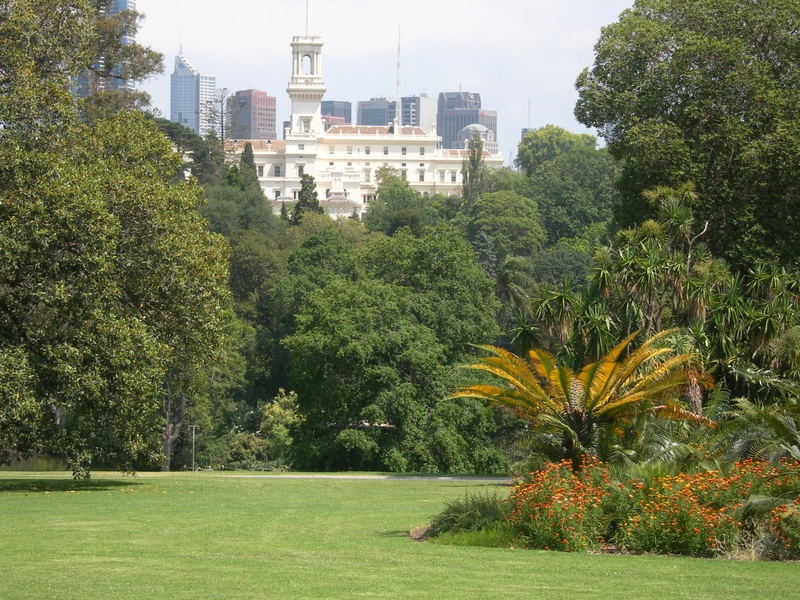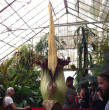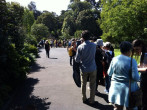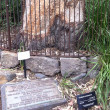ROYAL BOTANIC GARDENS
BIRDWOOD AVENUE MELBOURNE, MELBOURNE CITY
-
Add to tour
You must log in to do that.
-
Share
-
Shortlist place
You must log in to do that.
- Download report













Statement of Significance
What is significant?
The Royal Botanic Gardens, commenced in 1846 on the south side of the Yarra River on a site selected by Superintendent Charles La Trobe, are located adjacent to Government House, Melbourne Observatory and the Domain. In March 1846 John Arthur was appointed the first superintendent, and later an area of 2ha (5ac) was fenced and developed near Anderson Street and the Yarra River. The Botanic Gardens were later enlarged in 1875 to include additional land from the Domain. The Botanic Gardens reserve is now 36ha.
From 1846 the Botanic Gardens were planted and landscaped under early curators, Arthur and Dallachy. In 1853 Ferdinand von Mueller was appointed government botanist and commenced the National Herbarium. In 1857 Mueller became Director of the Botanic Gardens and under his direction the Botanic Gardens embarked on a scientific program, introducing foreign plants from other parts of Australia and overseas. Many plants and animals were acclimatised for scientific research and education. The Botanic Gardens contained a systems garden, glasshouses, palm house, iron arbours, gates and fences, animal enclosures, and an aviary. Walks were formed with avenues of trees, beds and lawns planted, and the lagoon with islands was landscaped. An Under-gardener's cottage was erected in 1850, and the Director's residence in 1854.
In 1873 William Guilfoyle was appointed Director of the Botanic Gardens and under his direction the landscape was redesigned in a more picturesque style; the straight paths were replaced by curved sweeping paths, avenues were removed, and the lawns were dotted with botanical collections in beds and specimen trees. The lakes and islands were further landscaped and altered in layout. Rustic bridges, rockeries, rotundas, pavilions, nursery buildings, and gate lodges were built. In 1901 the Temple of the Winds designed by Guilfoyle was erected as a memorial to La Trobe. The Nymphaea Lake was formed in 1903 and was the last major development by Guilfoyle before he retired in 1909.
The layout, established by William Guilfoyle between 1873 and 1909, has been maintained by subsequent Directors. The rustic bridges have been replaced and a few pavilions removed and new buildings erected, but the landscape generally conforms to the Guilfoyle style. There is continual renewal of the planting as plants have to be removed and new plants and collections introduced. The Botanic Gardens still retain many old plants, including remnant vegetation, trees from the Arthur, Dallachy, Mueller and Guilfoyle period, and plants rare in the wild. There are many plants of outstanding size and aesthetic and botanical value. A new Herbarium was constructed in 1934 as a gift from Sir Macpherson Robertson to celebrate the centenary of European settlement in Victoria. This new development included the addition of extra land to the Gardens and the erection of new gates (F Gate), originally from the Carlton Gardens. The Herbarium was further enlarged in 1988.
The glasshouses and a few gate lodges have been removed and replaced by modern buildings. The System?s Pavilion was removed and there have been numerous building changes in the Nursery. The Palm House which was relocated to the Royal Zoological Gardens is now in storage at Werribee Park. In 1964 the Nareeb Gates from a mansion in Toorak were relocated and are now at D Gate. A new herb garden was built in 1983 on the site of the former medicinal garden, and new plant collections have been established; including a grey garden, perennial border, grass garden, species roses, New Caledonia, California and Southern Chinese collections. In 1994 the William Tell Rest House burnt down and was replaced by a replica the following year. In 1999 a new path was formed between the Botanic Gardens and the Melbourne Observatory (Observatory Gate).
How is it significant?
The Royal Royal Botanic Gardens Melbourne are of historical, architectural, scientific, aesthetic, and social significance to the State of Victoria.
Why is it significant?
The Royal Botanic Gardens are of historical significance as Victoria's earliest botanic garden. The site was instrumental in the introduction and acclimatisation of plants, and animals, in Victoria. The involvement of Mueller and Guilfoyle, and the earlier curators Arthur and Dallachy, established the Botanic Gardens as the State's principal botanical resource and as the centre for botanical research in Victoria. The association of Ferdinand von Mueller, a botanist of international importance, as Government Botanist (1853-96) and Director of the Botanic Gardens (1857-73) and the founder of the National Herbarium is significant. Mueller was instrumental in supporting the establishment of regional Botanic Gardens and parks by providing many plants and advice, resulting in an exceptional collection of nineteenth century Botanic Gardens and plants in Victoria. Guilfoyle was involved in the redesign of a number of these Botanic Gardens, and several private gardens, and are all regarded to be outstanding examples of his landscape style.
The Botanic Gardens contain some of Victoria's oldest cultivated and commemorative trees. There are also remnant plantings of Eucalyptus camaldulensis, E. melliodora, and Melaleuca ericifolia. Beneath a large River Red Gum, known as the Separation Tree, Governor Charles La Trobe and the public celebrated the separation from New South Wales in July 1851. The 1846 English Elm trees known as Arthur's Elms are amongst the oldest known exotic trees in Victoria, and the Gardens retain a few other trees from the 1850s and 1860s. On his appointment as Director, William Guilfoyle planted an Algerian Oak in 1873.
The Royal Botanic Gardens are of aesthetic significance for the layout and planting established by William Guilfoyle between 1873 and 1909. It is an important nineteenth century landscape style that combines both picturesque and gardenesque landscape features, structures, botanical collections and the extensive use of subtropical species and bold foliage. The Botanic Gardens are of outstanding aesthetic significance incorporating a landscape of natural landforms, water, planting, buildings and structures. The layout is an outstanding response to the sloping site, and the landscape with sweeping paths, lawns, dense shrubberies, beds and specimen trees, internal and external vistas, and the location and design of buildings and structures impart a design of the highest quality. The Botanic Gardens are of outstanding beauty and the seasonal change, contrasting forms and foliage, and plant maturity form an attractive landscape. Key elements in the design is the use of water, landscaped islands, sloping green lawns, curved paths, triangular beds, rockeries, specimen trees, the mounds and a reservoir shaped as a volcano. The planting themes include an oak lawn, fern gully, palm collection, cactus garden, Australian border, Queensland collection, New Zealand beds and South African triangle. There are significant views to the Government House tower, Temple of the Winds and Director's residence.
Within the Botanic Gardens are several buildings and structures of historic and architectural significance. These include the 1850 Under-gardener's Cottage (now Craft Cottage), the oldest building in a public garden in Victoria; the 1854 Director's residence (now Gardens House) and home to Garden Directors until 1991; 1901 Temple of the Winds designed by Guilfoyle in a classical style incorporating staghorn fern capitals; an unusual masonry Directors' roll; and a significant collection of pavilions, gate lodges, arbours, seats, rockeries, gates and fences, and nursery buildings. In the Nursery is a rare example of a prefabricated iron house manufactured by Walmsley of London, and a paint shop with a roof lantern in a picturesque style.
The Royal Botanic Gardens and National Herbarium are of scientific significance as the centre of botanic research, plant acclimatization and species introduction into Victoria since its establishment in 1846. The living collections form the most extensive collection of plants in Victoria and are a depository for extinct, rare and threatened exotic, Australian and Victorian species. The Botanic Gardens contain several significant thematic plantings incorporating geographic, horticultural, and ecological collections. The Camellia collection is listed as the Australian National Reference Collection and the Viburnum collection is registered by the Ornamental Plant Conservation Association of Australia, and both are important reference collections.
The Royal Botanic Gardens are of social significance for the valuable recreational and educational role they provide to visitors. They are one of the State's major tourist attractions and include many international and interstate visitors of all ages. The Botanic Gardens play a major role in environmental, botanical, horticultural and aboriginal history education in Victoria. They have been a venue for major public events, including theatrical and musical performances, and official celebrations throughout their history.
-
-
ROYAL BOTANIC GARDENS - Permit Exemptions
General Exemptions:General exemptions apply to all places and objects included in the Victorian Heritage Register (VHR). General exemptions have been designed to allow everyday activities, maintenance and changes to your property, which don’t harm its cultural heritage significance, to proceed without the need to obtain approvals under the Heritage Act 2017.Places of worship: In some circumstances, you can alter a place of worship to accommodate religious practices without a permit, but you must notify the Executive Director of Heritage Victoria before you start the works or activities at least 20 business days before the works or activities are to commence.Subdivision/consolidation: Permit exemptions exist for some subdivisions and consolidations. If the subdivision or consolidation is in accordance with a planning permit granted under Part 4 of the Planning and Environment Act 1987 and the application for the planning permit was referred to the Executive Director of Heritage Victoria as a determining referral authority, a permit is not required.Specific exemptions may also apply to your registered place or object. If applicable, these are listed below. Specific exemptions are tailored to the conservation and management needs of an individual registered place or object and set out works and activities that are exempt from the requirements of a permit. Specific exemptions prevail if they conflict with general exemptions. Find out more about heritage permit exemptions here.Specific Exemptions:General Conditions: 1. All exempted alterations are to be planned and carried out in a manner which prevents damage to the fabric of the registered place or object.General Conditions: 2. Should it become apparent during further inspection or the carrying out of alterations that original or previously hidden or inaccessible details of the place or object are revealed which relate to the significance of the place or object, then the exemption covering such alteration shall cease and the Executive Director shall be notified as soon as possible.General Conditions: 3. If there is a conservation policy and plan approved by the Executive Director, all works shall be in accordance with it.General Conditions: 4. Nothing in this declaration prevents the Executive Director from amending or rescinding all or any of the permit exemptions.General Conditions: 5. Nothing in this declaration exempts owners or their agents from the responsibility to seek relevant planning or building permits from the responsible authority where applicable.Landscape* All works in accordance with the Royal Botanic Gardens, Melbourne Conservation Analysis and Conservation Constraints (1992).
* All works in accordance with the Royal Botanic Gardens Melbourne Master Plan (1998) and also subsequent revisions of the Master Plan or its equivalent as endorsed by the Executive Director, except for the following works identified in the Master Plan which will require a permit:Relocation of Lake View Pavilion‘A’ Gate and path worksAlteration of path inside ‘F’ gate* Maintenance of the existing hard surface landscape including paths, gutters, drainage using like for like materials where practicable.
* Removal of non-significant fencing and gates.
* Emergency or safety works to plants, structures, paths, drainage, services or other components.
* Management and maintenance of trees including formative and remedial pruning, removal of deadwood, pest and disease control, cabling (and similar supportive works), and (other than those listed in the Schedule), planting and removal.
* Development, management and maintenance of the living plant collections of the Gardens, in accordance with Collection Development Plans and consistent with the Master Plan.
* Management and maintenance of the general living landscape, including shrubberies, borders and turf.
* Installation, placement, modification and removal of components of directional, interpretive, public safety or informational signs, plant labels or other general signs.
* Construction, installation or maintenance of services such as water, electricity, lighting, communications cabling, sewer and drainage systems.
* Management of trees in accordance with Australian Standard; Pruning of amenity trees AS4373.
* Removal of plants listed as noxious weeds in the Catchment and Land Protection Act 1994.Buildings Exteriors:* Minor repairs and maintenance which replace like with like.
* Painting of previously painted walls, posts, and roofing.
* Treatments to stabilise and protect timber, metal and masonry structures.
* Removal of extraneous items such as external lighting, air conditioners, pipe work, ducting, flues, wiring, antennae, aerials, fly screens etc. and making good.
* Demolition of fabric in the course of alterations does not require a separate permit.
Buildings Interiors:* Painting of previously painted walls and ceilings provided that preparation or painting does not remove evidence of the original paint or other decorative scheme.
* Removal of paint from originally unpainted or oiled joinery, doors, architraves, skirtings and decorative strapping.
* Installation, removal or replacement of carpets and/or flexible floor coverings.
* Installation, removal or replacement of curtain track, rods, blinds and other window dressings.
* Installation, removal or replacement of hoods, nails and other devices for the hanging of mirrors, paintings and other wall mounted artworks.
* Refurbishment of existing bathrooms, toilets and or en suites including removal, installation or replacement of sanitary fixtures and associated piping, mirrors, wall and floor coverings.
* Installation, removal or replacement of existing kitchen benches and fixtures including sinks, stoves, ovens, refrigerators, dishwashers etc and associated plumbing and wiring.
* Installation, removal or replacement of electrical wiring provided that all new wiring is fully concealed and any original light switches, pull cords, push buttons or power outlets are retained in-situ. Note: if wiring original to the place was carried in timber conduits then the conduits should remain in-situ.
* Installation, removal or replace of bulk insulation in the roof space.
* Installation, removal or replacement of smoke detectors.
* Installation of stud walls, which are removable, other than in the principal rooms of the Director's House, Mueller's Hall and Under Gardener's Cottage.
* Installation of plant within the roof space.
* Installation of new fire services including sprinklers, doors and elements affixed to plaster surfaces.
* Removal or installation of balck, white notice boards and the like.
* Demolition or removal of non-original stud/partition walls, suspended ceilings or non-original wall linings (including plasterboard, laminate and masonite), non-original glazed screens/partitions, non-original flush panel or part glazed doors, non-original bathroom partitions and tiling, sanitary fixtures and fittings, non-original kitchen tiling, fittings and equipment, lights, modern built-in cupboards, shelves and benches, cubicle partitions, computer and office fitout and the like.
* Removal or installation of modern door and window furniture including hinges, locks, knobsets and sash lifts.
* Removal of tiling or concrete slabs in wet areas provided there is not damage to or alteration of original structure or fabric.
* Installation, removal or replacement of ducted, hydronic or concealed radiant type heating provided that the installation does not damage existing skirtings and architraves.
* Installation, removal or replacement of electric clocks, public address systems, detectors, alarms, emergency lights, exist signs, luminaries and the like on plaster surfaces.
* Installation of new built-in cupboards and shelving providing no alteration to the structure is required.
Other Structures:* Minor repairs and maintenance which replace like with like.
* Painting of previously painted walls, posts, and roofing in the same colour.
* Treatments to stabilise and protect timber, masonry and iron structures.
* To repair, replumb or refit the steel bowl, concrete bowls and any replumbing and repair work on drinking fountains.
In accordance with s92(3) of the Heritage Act 2017, permit exemption issued by the Executive Director, Heritage Victoria on 13 October 2020 (P33541):
Gardens HouseTemporary event use at Gardens House from 2020-2024, in accordance with the document ‘Heritage Management Guidelines for Tenant Events 2020-2024’, dated October 2020, prepared by Andrea Proctor Landscapes. The following applies: installation of one marquee of maximum dimensions of 17m x 22m, plus a catering marquee of maximum dimensions 4m x 10m. Turf regeneration or replacement must be undertaken as required at the conclusion of the event.- For the Front Lawn:
- Between 1 September – 29 February, for a maximum of 22 days (including bump in and bump out). There must be a minimum of 28 days (for turf regeneration) or 45 days (for turf replacement) rest period after event use.
- Between 1 March – 31 August, for a maximum of 22 days (including bump in and bump out). There must be a minimum of 45 days (for turf regeneration) or 60 days (for turf replacement) rest period after event use.
- For the Back Lawn:
- At any time of the year, for a maximum of 11 days (including bump in and bump out). There must be a minimum of 21 days rest period after event use for turf regeneration.
Garden Lawn AreasTemporary event use in the following Garden Lawn areas from 2020-2024, in accordance with the document ‘Heritage Management Guidelines for Tenant Events 2020-2024’, dated October 2020, prepared by Andrea Proctor Landscapes. The following applies: installation of one marquee of maximum dimensions of 17m x 38m with a 7m x 24m deck and one supporting 8m x 12m catering tent. Marquees are to be neutral coloured, tented structures with a suspended solid floor. Marquee sides can be used where required. Only one lawn location may be used for a marquee by the tenant at any time.- Nymphaea Lake West:
- From 1 April – 31 August and 3 January – 31 January, for a maximum of 4 days (including bump in and bump out). There must be a minimum rest period of 14 days after event use.
- From 1 September – 2 January, for a maximum of 26 days (including bump in and bump out). There must be a minimum rest period of 45 days after event use.
- From 1 February – 31 March, for a maximum of 18 days (including bump in and bump out). There must be a minimum rest period of 45 days after event use.
- On Dog Flat or Eastern Lawn (near Tecoma Rest House):
- From 29 October – 5 November 2020 (including bump in and bump out. There must be a minimum rest period of 21 days after event use.
- From either 1 – 23 December 2020 (including bump in and bump out) or 9 March – 31 March 2021. There must be a minimum rest period of 28 days after event use.
- From 25 October – 20 December 2021 (including bump in and bump out). There must be a minimum rest period of 45 days after event use.
- From 24 October – 19 December 2022 (including bump in and bump out). There must be a minimum rest period of 45 days after event use.
- From 30 October – 20 December 2023 (including bump in and bump out). There must be a minimum rest period of 45 days after event use.
- From 28 October – 23 December 2024 (including bump in and bump out). There must be a minimum rest period of 45 days after event use.
Small Scale Events from 2020-2024 at Nymphaea Lawn West, Nymphaea Lake East, Tecoma Rest House and Taxodium Lawn in accordance with the document ‘Heritage Management Guidelines for Tenant Events 2020-2024’, dated October 2020, prepared by Andrea Proctor Landscapes:- For small scale events (up to 350 pax, no marquee) installation of infrastructure for no more than 8 hours, of up to 150 chairs, a small arch and PA system may be used. Occasionally events may use up 350 chairs to accommodate specific cultural requirements of the celebration. All items are to be weighted or placed on lawns, with no items to penetrate the lawn surface. All items are to be packed away within 2hrs of the conclusion of the event.
It is understood that minor changes may be required to the above approved permit exempt events from time to time in relation to a Covid Safe Plan or other reason. An outline of what these changes are, and their likely impacts, is to be provided to the Executive Director, Heritage Victoria in writing, who will assess whether the changes may be accommodated under the scope of these permit exempt events.The Executive Director must be notified every six months of the following;- High level summary of events that have taken place at each location;
- The extent of damage, if any, to the place as a result of the above;
- The works undertaken to rectify the affected areas of the place if required.
ROYAL BOTANIC GARDENS - Permit Exemption Policy
POLICYConservation and Management of the Botanic Gardens should retain the landscape character (referred to as the "Guilfoyle style") to include conifers, palms, evergreen and deciduous plants, bold and tropical foliage, planted in beds and shrubberies, and as stands and specimen trees in lawns. The importance of the Botanic Gardens lies primarily in its layers of development and planting which combine to create a cultural landscape of considerable individuality and diversity, and in its continuing role as a significant scientific institution.
The Royal Botanic Gardens, Melbourne Conservation Analysis and Conservation Constraints (1992) for the Royal Botanic Gardens by Nigel Lewis Richard Aitken P/L in association with staff of the Royal Botanic Gardens clearly establishes the significance of the place, and identifies significant fabric and provides conservation policies to guide the management of the Botanic Gardens and its components.
The Royal Botanic Gardens Master Plan (1998) identifies the planting character of the various zones which make up the whole landscape, and establishes a framework for future development of the landscape and the living plant collections within it. The Master Plan recognises the conservation significance of the site.
- For the Front Lawn:
-
-
-
-
-
FORMER GRAND RANK CABMAN'S SHELTER
 Victorian Heritage Register H0849
Victorian Heritage Register H0849 -
SHRINE OF REMEMBRANCE
 Victorian Heritage Register H0848
Victorian Heritage Register H0848 -
FORMER KELLOW FALKINER SHOWROOMS
 Victorian Heritage Register H0668
Victorian Heritage Register H0668
-
Archaeological site
 Southern Grampians Shire
Southern Grampians Shire -
Avoca
 Stonnington City H0809
Stonnington City H0809 -
BANYULE
 Victorian Heritage Register H0926
Victorian Heritage Register H0926
-














